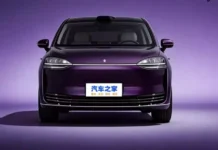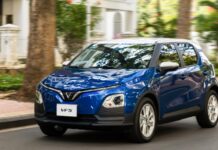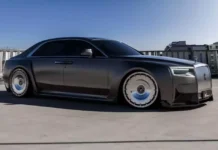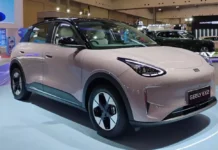With the rising popularity of electric vehicles (EVs) in Vietnam and exaggerated advertisements claiming their superior water wading capabilities, consumers are led to believe that EVs can safely navigate through deep waters, outperforming traditional gasoline and diesel cars. This belief is further reinforced by the frequent flooding in major cities like Hanoi and Ho Chi Minh City, making the water resistance of EVs a top concern for consumers.
Let’s explore whether EVs can indeed comfortably wade through water and understand the appropriate usage of these vehicles.
Electric Vehicle Construction and Water Resistance
The fundamental difference between EVs and traditional automobiles lies in their propulsion systems. EVs utilize high-voltage batteries (typically 300–800V), electric motors, and electronic control systems instead of internal combustion engines. This distinction raises concerns about potential short circuits or electrical shocks due to water exposure.
However, according to experts and manufacturers, most modern EV batteries and high-voltage components are protected by IP67 or higher water resistance standards. This means they can withstand submersion in 1 meter of water for 30 minutes without damage. Additionally, batteries are typically enclosed in sealed metal casings with waterproof gaskets and undergo rigorous testing before leaving the factory.

EV battery system installed in the floor of the vehicle
In fact, many current EV models have water wading capabilities equivalent or superior to their gasoline counterparts in the same segment, thanks to their flat underbody design and the absence of air intakes or exhaust pipes. Gasoline engines face the risk of hydrolock if water enters the combustion chamber, whereas EVs are not susceptible to this issue.
Manufacturer Statements on Water Resistance
Several prominent EV manufacturers have publicized the water resistance and wading capabilities of their products. However, it’s important to note that these tests are conducted on brand-new vehicles without any damage or wear on their components. For vehicles that have been in use for an extended period, there is no guarantee that all parts remain in perfect condition. Therefore, it’s advisable not to push the vehicle beyond its limits.
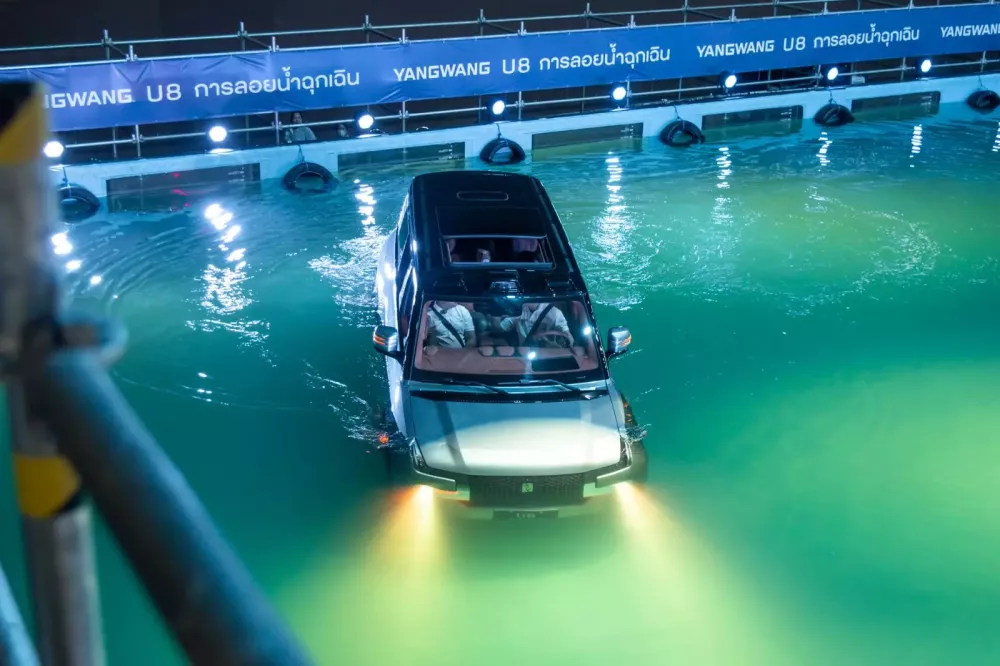
The BYD Yangwang U8, marketed for its exceptional water wading capabilities, akin to “swimming” in a 1200 mm deep pool.
Tesla Model X and Model S: These vehicles have been tested for safety when traversing through approximately 0.5 meters of floodwater. While Elon Musk has stated that Teslas can “act like a boat for short periods of time,” the company does not recommend using their vehicles in this manner.
BYD, Nio, and Xpeng (Chinese manufacturers): Several of their electric SUV models are promoted as capable of safely wading through 500–600 mm of water.
VinFast VF 8 and VF 9: According to the manufacturer, the vehicles’ batteries meet the IP67 water resistance standard, and they can traverse through 30–40 cm of floodwater.
A common thread among these manufacturers is their recommendation against intentionally driving in deep floodwaters, despite the vehicles’ water resistance capabilities. This is analogous to owning an iPhone 13 or newer, which is advertised as water-resistant, but you wouldn’t deliberately submerge it in water or leave it out in the rain.
Potential Risks of Electric Vehicles Wading Through Deep Water
Nevertheless, this does not imply that EVs are entirely safe when wading through deep water. Several potential risks remain, including:
Short Circuit Risk:
If water penetrates low-voltage connections (12V systems, sensors, connectors), the vehicle may experience electrical faults, system errors, or even stall in the middle of a flood.
Component Corrosion:
Dirty water, especially floodwater mixed with mud, debris, or saltwater in coastal areas, can cause corrosion of metal parts, damage to connectors, and reduced vehicle lifespan.
Long-Term Battery Risks:
Although batteries are water-resistant, frequent deep submersion or impact while flooded can compromise the protective casing. In severe cases, water ingress into the battery may lead to “thermal runaway,” resulting in overheating and explosions.
Brake and Suspension Damage:
Similar to gasoline vehicles, deep water can temporarily impair the braking system, wash away lubricants, and cause long-term damage to the suspension.
Passenger Safety Hazards:
While the risk of electric shock is virtually non-existent due to high-voltage isolation systems, if the vehicle stalls in strong currents, passengers may find themselves trapped in a dangerous situation, especially if the water level rises rapidly.
Comparing Electric and Gasoline Vehicles in Flooded Areas
Gasoline/Diesel Vehicles: Prone to hydrolock due to water entering the air intake and combustion chamber. Engine repairs after hydrolock can be costly.
Electric Vehicles: Immune to hydrolock, but susceptible to electronic system damage and corrosion. Prolonged submersion can significantly impact the battery.
In summary, EVs offer a safety advantage over gasoline vehicles in mild flooding situations by eliminating the risk of hydrolock. However, both types of vehicles face significant risks and should not be driven through deep floods (over half the wheel height).
Recommendations for EV Users in Vietnam
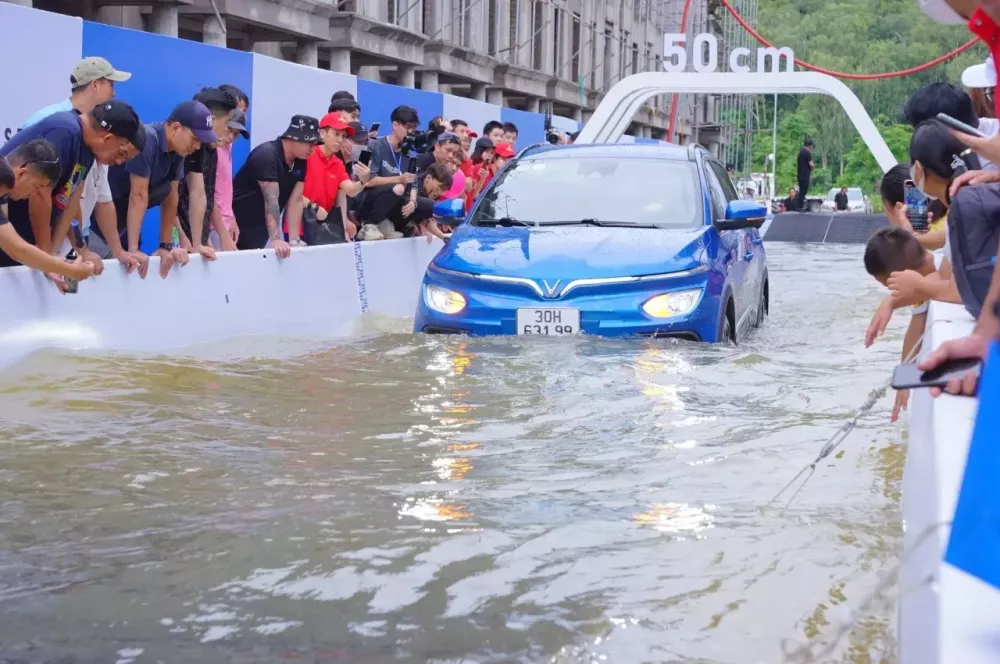
Although EVs have good water resistance and wading capabilities, experts advise against driving them through water whenever possible and never in depths exceeding 50 cm.
To minimize risks, experts offer the following advice:
Avoid Overconfidence in Water Resistance: While EVs offer a certain level of water resistance, it doesn’t imply absolute safety. If the water level rises above half the wheel height, it’s best to stop and find an alternative route.
Thorough Post-Flood Inspection: After traversing through a flooded area, have the vehicle inspected at a service center to check the electrical system, brakes, and underbody for any damage.
Avoid Prolonged Parking in Flooded Areas: Water can gradually seep into the vehicle’s systems if it’s submerged for too long, causing damage to the interior and electrical/electronic systems.
Beware of Saltwater: Flooding in coastal areas or during high tides often contains saltwater, which can accelerate corrosion and pose a significant threat to EVs.
Choose Vehicles with Clear Water Resistance Certifications: When purchasing an EV, consumers should review the technical specifications and inquire about the vehicle’s water wading capabilities and the water resistance standard of the battery and motor.
Should You Drive Your EV Through Deep Water?
The short answer is: No.
While modern EVs offer adequate protection in mild flooding conditions, deep water wading always carries potential risks of damage and safety hazards. This is especially true in the context of Vietnamese traffic, where floodwaters are often contaminated with debris, mud, and even chemicals.
EVs are not “amphibious vehicles.” Their water resistance feature is intended as an emergency safeguard, not an invitation to venture into flooded areas.
Conclusion
Electric vehicles hold an advantage over gasoline cars in certain mild flooding scenarios by eliminating the risk of hydrolock. However, they are not immune to risks when wading through deep water. It is crucial for users to understand the limitations of their vehicles, adhere to the manufacturer’s recommendations, and refrain from driving through severely flooded areas.








